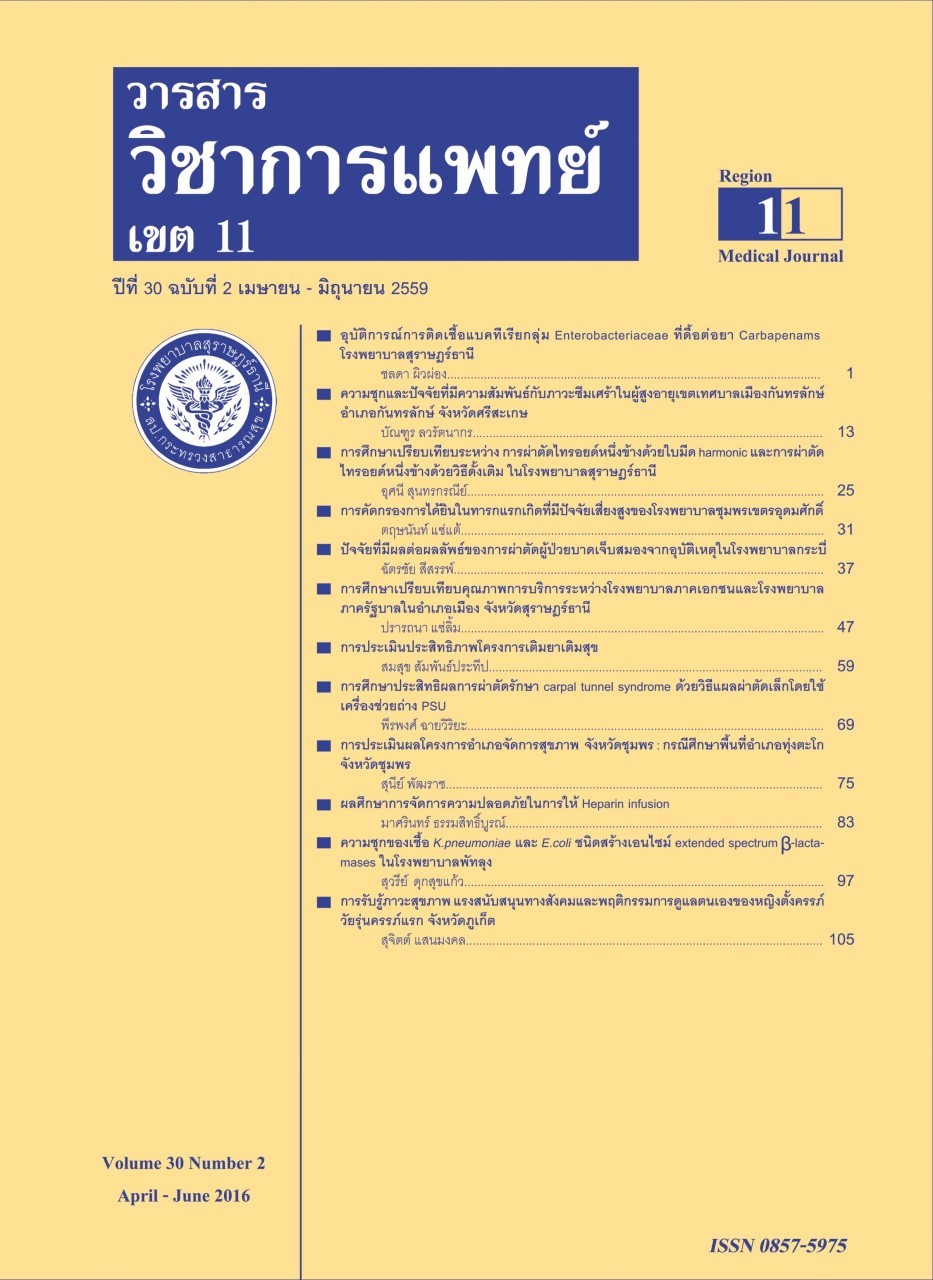The prevalence of extended spectrum Beta-lactamase producing in K.pneumoniae and E.coli at Phatthalung hospital
Keywords:
ฺB-lactamase, ESBL, Prevalence of extended spectrum B-lactamase producingAbstract
Drug resistance in Enterobacteriaceae is the most common mechanism resulted by producing Extended–Spectrum -lactamase (ESBLs) of bacteria, especially, K.pneumoniae and E.coli. This retrospective descriptive study aimed to explore the prevalence of K.pneumoniae and E.coli which producing ESBLs and their sensitivity to group ofcephalosporins. This study collected data from microbiology reports of all clinical specimens of the Laboratory Department at Phatthalung hospital from 1 January 2010 to 31 December 2014 and descriptive statistic was used to analyze these retrospective data. As a result, 9, 413 strains of K.pneumoniae and E.coli were found and 3,444 of them produced ESBLs (36.58%). While, 1,849 K.pneumoniae strains (38.66%) and 1,595 E.coli strains
(33.44%) producing ESBLs were identified. Regarding to host, 59.61% of ESBLs belonged to male and 24.24% of ESBLs occurred in adultsaged between 71 to 80 years old. Most K.pneumoniae and E.coli strains were reported occurring in Medicine wards, 55.54% and 54.80% respectively. Regarding to specimen types, K.pneumoniae producing ESBLs were mostly from sputum (65.22%), while E. coli producing ESBLs were mostly from urine (58.75%). For drug sensitivity, 99.87%, 99.75%, .99.66% and 94.19% of these K.pneumoniae strains presented good response to imipenem, meropenem, amikacin and gentamicin, respectively. While, 92.07%, 99.70%, and 91.62% of theseE. coli strains presented good response to gentamicin, amikacin and cefoperazole/sulbactam, respectively. Significantly, all of these E.coli strains had shown good response to imipenem and meropenem.
References
2. Knote H, Shah P Kremery V, Antal M, Mitsuhashi S. Transferable resistance to cefolaxime, cefoxitin, cefamandole and cefuroxime in clinical isolate of
Klebsiella pneumoniae and Serratiamereescens. Infection 1983 ; 11(6):315-7.
3. Tangden T, Kars O, Mehus A, Lowdin E. Foreign travel is a major risk factor for colonization with Escherichia coli producing CTX-M-type extendedspectrum beta-lactamases:a prospective study with Swedish volunteers. AntimicrobagenChemother. 2010;54:3564-8.
4. Sunita P, Jessica AV, Margriet K, Romy M, Marguerite LB, Alexandra TB, et al. Extended-Spectrum Beta Lactamase- producing Enterobacteriaceae among
Travels from Netherlands. Emerging Infectious Diseases 2013;19: 1206-1213.
5. Ben-Ami R, Rodriguez-Banno J, Arslan H, Pitout JD, Quentin C, Calbo ES et al. Extended spectrum beta lactamase producing Enterobacteriaceae in
nonhospitalized patients. Clin Infect Dis.2009;49(5):682.
6. ธานี จงษ์วัย และศิริลักษณ์ ธีระภูธร. เชื้อวงศ์เอนเทอโรแบคทีเรียในกระแสเลือดที่สร้างเอนไซม์ Extended-spectrum Beta-Lactamase ณ โรงพยาบาลแม่สอด.พุทธชินราช
เวชสาร 2554; 28(3) : 233-8.
7. ชัยพร การะเกตุ. ความชุกของเชื้อ K.pneumoniae และ E.coli ชนิดสร้างเอนไซม์ extended spectrum B-lactamase ที่โรงพยาบาลเชียงคำระหว่างปี พ.ศ.2554-2555
วารสารโรงพยาบาลพิจิตร 2556; 28(1) 21-29.
8. ศิริลักษณ์ ธีระภูธร, สุรกิจ หน่อคำหล้า, ศรัญญาสกาน และสุนีย์นุช บัวติ๊บ. ผลการตรวจหาแบคทีเรีย กลุ่ม Enterobacteriaceae และ Pseudomonas aeruginsa ที่ผลิตเอนไซม์ ESBL และ AmC B-lactamase ด้วยวิธี Inhibitor Based. พุทธชินราชเวชสาร 2553; 27(2):212-218.
9. Sharma M, Pathak S, Srivastava P. Prevalence and antibiogram of Extended Spectrum – Lactamase (ESBL) producing Gram negative bacilli and further
molecular characterizertion of ESBL producing Escherichia coli and Klebsiella spp. Journal of Clinical and Diagnotic Research 2003; 7(10):2173-2177.
10. Chandrer A, Shrestha CD. Prevalance of extended spectrum beta lactamase producing Escherichia coli and Klebsiellapneumoniae urinary isolates in a tertiary care hospital in Kathmandu, Nepal. BMC research notes 2013;6:487-492.






